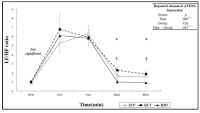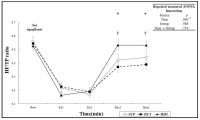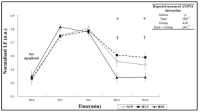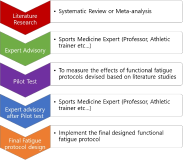
Purpose The purpose of this study was to investigate the effects of a functional fatigue protocol on lower extremity dynamic and static postural control. Methods A total of 20 physically active collegiate students participated in this study (ten males, ten females; age 22.5±2.7 years; mass 67.0±13.0 kg; height 168.0±8.9 cm). A unilateral stance with eyes closed for 10 seconds was performed to test static postural control using a balance force plate and single-leg drop landing on 30cm box was performed as a dynamic postural control test and captured using VICON motion analysis system. Results The results of this study showed an average heart rate of 176.3 beats/minute, an 18 rating on the perceived exertion scale, significant differences in blood lactate, and a static postural control deficit after fatigue as compared with before fatigue(p<.05). Dynamic postural control after fatigue changed landing strategy in the form of stiff landing. Knee flexion was decreased at initial contact and at peak vertical ground reaction force, also, both decreased valgus and internal rotation of knee joint. Conclusions This protocol may use for enhancing fatigue-endurance training as well as for inducing fatigue. Further, to ascertain a landing strategy, it is recommended to increase landing height to clearly observe changes in landing strategy.





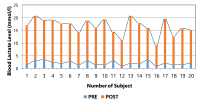
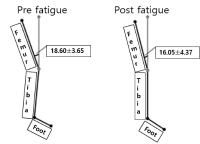


Purpose The purpose of the study was to investigate the effect of vibratory stimulus on the static postural control of 8 healty senior adults. Methods To achieve this goal, all subjects participated in two different kinds of static postural control tasks. Task 1 was a static postural control task, where both-legs stand on the ground. Second task was an unstable static postural control task using only single leg stance. As they maintain their balance, 6 different vibratory stimulus were provided on the sole of their feet(personal threshold 0%, 80%, 90%, 100%, 110%, 120%). Results The results of the study were as follows: First, there was no significant differences in postural control ability according to different types of vibrator intensity. Second, there was a significant difference in single-leg postural control ability according to vibrator intensity. Third, there was a significant difference in anterio-posterior stability according to the different types of vibrator intensity. Conclusion Stochastic resonance using vibratory stimulus was more effective in the single leg stance task, rather than the double leg stance task. Moreover, sub-threshold vibratory stimulus(80%, 90%) intensity were more effective than higher vibratory stimulus(100%, 110%, 120%).


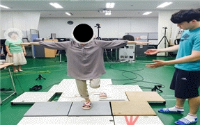

PURPOSE The purpose of this study was to compare the dynamic postural control of youth athletes with and without a history of lateral ankle sprains. METHODS Twenty-eight youth athletes (14 lateral ankle sprain, 14 healthy control) participated in this study. All participants answered the Foot and Ankle Ability Measure questionnaire and were subject to the Star Excursion Balance Test (SEBT) for dynamic postural control evaluation to collect the joint angles of the lower extremity, a center of pressure (COP) path, and COP velocity. Independent sample t-test or Mann-Whitney U-test were performed to analyze the difference between the groups. RESULTS The lateral ankle sprain group (LAS) was found to have a long experience in participating in sports, and low Foot and Ankle Ability Measure scores were identified when compared to the healthy control (CON; p<0.05). LAS was observed with a short reach distance, less hip flexion, and dorsiflexion angles during the anterior direction of SEBT when compared to CON (p<0.05). Furthermore, LAS showed a slower anteroposterior and mediolateral center of pressure velocities in the posteromedial aspect of SEBT and a slower anteroposterior COP velocity in the posterolateral aspect of SEBT when compared to that of CON (p<0.05). There were no differences between the groups with respect to the other variables (p>0.05). CONCLUSIONS Based on these results, decreased anterior reach distance of SEBT may be affected by changing the dynamic posture control strategy of the lower extremity joint on the sagittal plane in LAS.

The purpose of this study was to examine the influence 12 weeks of Hatha yoga exercise has upon changes in postural control ability of high school girls. The research subjects were 27 high school girls (yoga group: 15, control group: 12). Changes that took place after yoga exercise were comparatively analyzed after having them train Hatha yoga for 12 weeks. The research variables that were measured were the moving range of COP in static postural balance, Rambling & Trembling in the moving range of COP, and postural change in the sagittal plane. The mean and the standard deviation(SD) were calculated on each measurement item by using the SPSS Ver 21.0 statistical program. To verify difference in pre-value between groups, an independent t-test was carried out. The verification of change according to time within the group after 12 weeks of yoga exercise was conducted in a paired t-test. To inspect interaction by time and group before and after yoga exercise, two-way repeated measures ANOVA was implemented. As a result, the moving distance of the pre and post direction in the moving range of COP was reduced. Rambling and Trembling in the pre-and-post direction significantly decreased. And in postural change of the sagittal plane, there was significant interaction between two groups in the neck and thigh parts. It was thought that the 12 weeks hatha yoga exercise has positive influence upon improving the postural control mechanism in female high school students and has an effect even on change in the postural control ability of an individual.

PURPOSE The quiet eye (QE) is defined as the final fixation time that is a specific target prior to initiating movement. This study aimed to identify the cause of QE in golf putting and to present an efficient practice method for improving putting skills. METHODS Thirty participants were randomly assigned to one of three groups. Each group practiced golf putting in different ways for two days. RESULTS The QE group showed a significant difference in putting scores, which was higher than that of the control group. The visual-occlusion group showed no difference compared to the other groups in terms of putting scores. The QE group showed a significant difference in terms of QE in the retention and competition tests compared to the pretest. The control group tended to have a slightly longer QE in competition tests compared to the pretest. The visualocclusion group showed no statistically significant difference in QE based on the period. All three groups had significantly longer swing times over the selected period. There was no significant difference in terms of the alpha power of the occipital lobe based on group and period. CONCLUSIONS The position of the visual-occlusion group became stable. However, the QE did not lengthen. The QE group had a longer QE. Furthermore, the control group that practiced with their eyes open tended to have longer QE. Therefore, QE may be related to visual-based cognitive processing rather than posturalkinematics. Finally, this study proved that QE practice is a more efficient method for novices in golf putting.
Purpose The purpose of this study was to analyze the effect of push-up plus exercise(PUPE) on stabilization of the scapula and to use it as basic data for shoulder rehabilitation program. Methods In this study, research papers were collected using Research Information Sharing Service(RISS) and Pub-Med Central.(PMC) as a search term for scapular stabilization, push - up plus, shoulder joint injury rehabilitation and scapular stabilization exercise. Also, it was used as basic data of literature analysis. The collected data were classified into the structure and movement of the scapula and shoulder, kinesiologic relation of the scapula and the mechanism of injury, and the effect of push-up plus Results Serratus anterior is a typical stabilizing muscle, and it forms a force couple with the upper and lower trapezius to control the movement of the scapula. The PUPE is an effective exercise method to selectively strengthen serratus anterior, which are the stabilizing muscles of the scapula, and is an exercise method that is also useful for correcting the wrong postures and movements because of hypertonus upper trapezius. In addition, various conditions such as application posture, arm position, and ground instability were suggested during PUPE. Conclusion The results of this study confirmed that PUPE is an effective program for scapula stabilization in the rehabilitation of shoulder injuries and injured patients and athletes. The PUPE will be used as a rehabilitation exercise program for patients and athletes who need rehabilitation of the shoulder joint.
Purpose : The purpose of this study was to investigate coaching information with which coaches provided players during badminton competition. Methods : To this end, we generated an open-ended questions and presented it to 88 high school athletes registered in the Badminton Korea Association. The survey was conducted during a tournament and immediately after the tournament to collect the data. The collected data were categorized through inductive content analysis. Results : As a result of this study, a total of 480 raw data points collected through the open-ended survey were categorized into four general areas: psychological information, technical information, tactical information, and game operation information. Specifically, psychological information was divided into six subdivisions: concentration, confidence, relaxation/stabilization, mental toughness, play thought, and passion; technical information was broken into four subdivisions: strokes, footwork, swing and posture, and position preparation; tactical information had four subdivisions: coping to opponents, play changes, rotation, and manipulation of opponents; and, game operation information was divided into two subdivisions: taking the lead in a game and changing atmosphere. Conclusions : In other words, in badminton competition, the coaches strengthened psychological skills that promote psychological stability to attain the athletes’ peak performance and modified the athletes’ motion into the action necessary for achieving accurate techniques. Furthermore, they provided a variety of coaching information so that the athletes will respond appropriately to their opponents’ play, take the lead in games and induce a positive mood. The psychological, technical, tactical and game operation information offered by badminton coaches are the main factors influencing the performance of badminton players and suggest a need for the proper management and control of the coaches as well as athletes for the peak performance.

This study was aimed at investigating the effect of head-tilt angle on autonomic nerve modulation immediately after a single bout of exercise in twenty-three healthy young males(age 21.96 ± .4 yrs). Post-exercise HRV was measured on supine(SUP), -15°head-down tilt(HDT), and +15°head-up tilt(HUT) followed by 20 min aerobic exercise with moderate intensity(40% of VO2max). As results, heart rate recovery during post-exercise on each tilt angle(SUP vs. HDT vs. HUT) had no significant difference(p> .05). Also, there were no significant difference in time and nonlinear domain index of HRV. On spectral analysis; however, frequency domain index(HF, LF/HF ratio, HF/TP ratio, HF nu, LF nu) had significant difference(p< .05) on each tilt angle at recovery. Especially, PNS reactivation index (HF, HF/TP ratio, HF nu) had significant increase on HDT compared to HUT(p<. 05) while SNS activation index (LF/HF ratio, LF nu) had significant decrease on HDT compared to HUT(p<. 05). Furthermore, there were significant interaction between recovery time elapsed and each tilt angle (except for HF/TP ratio). In conclusion, -15°head-down tilt promotes the effective cardiac vagus nerve reactivation immediately after a single bout of aerobic exercise.


